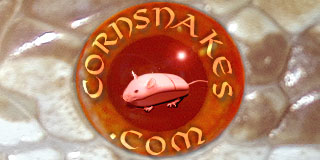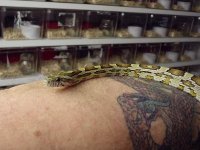I think that Lavenders and Caramels should be in the Anery Group. It is hard for people to accept that a Hypo Lavender for instance is a “Ghost” Lavender, but it is. An Amber Corn is also a “Ghost” Caramel. The Lavender and Caramel morphs do eliminate or greatly reduce the red pigment, but also add color to the morph as well. This is why people don’t really accept that a Hypo Lav is a Ghost, because it is colorful and not similar to other black and gray ghost.
I think the Caramel gene should be included in the Anery group, because of the way it combines with the Amel gene. A Snow Corn is Homo Anery A and Amel. They have no black or red coloration. A Butter Corn is Homo Caramel and Amel. They have no black or red pigment, but do have added yellow coloration. To me this puts them in the Anery group, but with a color twist. When they are first born, they can be mistaken for Snow Corns, but after a couple of sheds, the yellow really starts to develop.
The same exact thing occurs with the Lavender gene, when combined with Amel. Homo Lavender and Amel corns do not have any red or black pigment, but have added lavender coloration. This puts them into the same Anery group just like Caramels, but they add lavender color instead of yellow.
We see a lot of secondary colors in Snows and Lavenders, but the main colors of black and red are gone. These secondary colors of pinks, and orange are just now beginning to really surface due to selective breeding. The same could be said about Caramels. The normal yellow color of corns has been selectively bred for in that group, but they do seem to have a gene that adds yellow as well.
I think the Anery Group of Corns includes, Anery A, Black Corn, Anery B, Charcoal Corn, Anery C, Caramel Corn, and Anery D, Lavender Corn. The last two not only take the red pigment away but add a wonderful color twist to the equation. The test for the Anery A Group is how they combine with Amel, very much like the test for the Hypo Group is how they combine with Anery A or any other Anery Group of corn.
The morphs also could be included in the Anery Group by how they combine with the Hypo Group. All four of the Anery Group can be linked together by how they combine with the Amel or Hypo groups as well. They all produce a “Ghost” Type morph when combined with Hypo. Some just happen to be in color instead of black and white.

